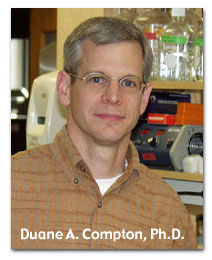For Release: 2 P.M. ET, April 10, 2003
Contact: DMS Communications (603) 650-1492
Print Version
Failures in Primate Cloning May Signal Impossibility of Reproductive Cloning, Scientists Find
HANOVER, NH - Deep-seated flaws in embryonic development may make therapeutic cloning of nonhuman primates difficult, and reproductive cloning of primates - nonhuman and human alike - impossible, report a team that includes a DMS biochemist and University of Pittsburgh scientists in the April 11 issue of Science.

"The experiments look at the possibility of cloning in primates using monkeys as a model system," said Dr. Duane Compton, associate professor of biochemistry, one of the authors. "The results stand in stark contrast to the recent successes of cloning in domesticated animals (sheep, cats, cattle, pigs, mice, etc), and suggest that cloning with currently used techniques is not going to succeed in primates because of severe chromosome abnormalities."
Therapeutic cloning involves the limited cell division of an unfertilized egg cell to develop embryonic stem cells, specialized cells that have shown promise in treating various conditions ranging from spinal cord injuries to Parkinson's disease and diabetes. Reproductive cloning involves the transfer of such a manipulated egg cell into a living surrogate female for a successful pregnancy, which is how researchers created Dolly the sheep a few years ago.
Basic molecular obstacles were observed that blocked normal cell development in the study, despite using four different techniques of nuclear transfer, according to the study's senior author, Dr. Gerald P. Schatten, director of the Pittsburgh Development Center at the Magee-Womens Research Institute and professor of obstetrics, gynecology and reproductive sciences and of cell biology at the University of Pittsburgh School of Medicine. "The chromosomes do not split properly. From the very first cell division, development was inappropriate in vital ways."
The researchers used known methods of nuclear transfer that have been developed for cloning of domesticated animals to manipulate 716 eggs retrieved from female rhesus macaques. Although 33 embryos were transferred into surrogates after initial cell division, no pregnancies were established. Imaging of DNA and cell structure revealed that while cell division continued in a superficially normal manner, chromosomal problems existed within each individual cell.
Tagging the cell proteins and DNA with antibodies to track progress, the investigators observed that some fundamental things that normally occur when cells divide didn't happen. Among key structures involved in cell division is the mitotic spindle, which precisely aligns and accurately separates chromosomes. However, examination of spindle configuration in cells originating as a result of nuclear-transfer revealed chaotic structures and unequal chromosome counts. Even the most basic proteins involved in spindle formation were absent or inadequate, Compton, an expert in spindle organization and chromosome movement in mitosis, and his colleagues found.
They conclude, "With current approaches, nuclear transfer to produce embryonic somatic cells in nonhuman primates may prove difficult -- and reproductive cloning unachievable."
For more information, contact Duane Compton: duane.compton@dartmouth.edu.